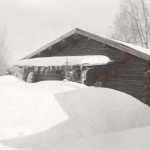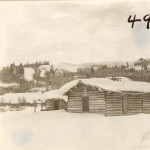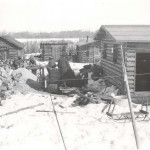When the Wilson families moved into Jackson Hole in the late fall of 1889, it was too late in the year to construct their own cabins. Trees needed to the cut, and left to dry in the area where they could be shaped into logs for a cabin. Winter in Jackson Hole fell swift and deep, and in November, it was time to prepare for many months of snow. Upon the families’ arrival, several bachelors were already living in the valley. Theirs was a solitary existence, often raising hay in the summer and wintering elsewhere. In 1889, roughly 28 people had made Jackson Hole their permanent home. Between Sylvester, Ervin and Nick Wilson, Selar Cheney, their wives, and their collective 24 children, they more than doubled the existing population.
“The bachelors,” as they were known, were more than accommodating to the newcomers. John Carnes and his wife had already built a second cabin (on today’s Elk Refuge), and graciously volunteered the older one to Sylvester and Mary Wilson, and their seven children. Will Crawford opened his cabin to Nick and Matilda Wilson, and their eleven children. John Holland, neighbor to Carnes, opened his home to Selar and Mary Wilson Cheney, and their three children. Finally, Ervin and Mary Wilson and their newborn son lodged with John Cherry. The sixty-three members of the emerging community of Jackson Hole settled in for the long cold months ahead. With little work to do, other than tending their stock and managing hay reserves, they passed the time by visiting with each other and hosting all-night parties.
- Winter snows piled up against a cabin.
- Cabins in winter.
- Winter in Jackson Hole.
Winter travel in the valley was dangerous at best, even in broad daylight. At night, it was a fool’s errand. The neighbors would arrange to meet at one of the cabins, and to cook and bring the necessary foodstuffs for a party. The men brought musical instruments for entertainment. They’d talk and dance all night long, with a brief respite for dinner at midnight. By the first dawn light, the families would depart for home. This type of winter entertainment became a mainstay in the traditions of the valley as it became more populated. When the town of Jackson was platted, and the main gathering place constructed in the Clubhouse in 1897, the entire valley would turn out for a night of revelry. Bunks were built along the walls to house sleeping children. Eventually, dance halls began popping up around the valley, providing more space for the increasing population and in locations that made travel easier. For residents of Moran, it was more than a day’s trip to Jackson for such an event. These gatherings allowed neighbors to converse and catch up during a season when they could go weeks without seeing another person outside of their immediate family. Wives in particular looked forward to the dances as rare opportunities to see other women, friends, and relatives.
At the first sight of green in the spring of 1890, Nick Wilson took his horse out to survey the area to see where the snow departed first. He made his way over to present-day South Park and found that Flat Creek was already running. It was in this vicinity that he, Sylvester, Ervin Wilson, and Selar Cheney decided to construct their homesteads.
Continue on to CABIN CONSTRUCTION







